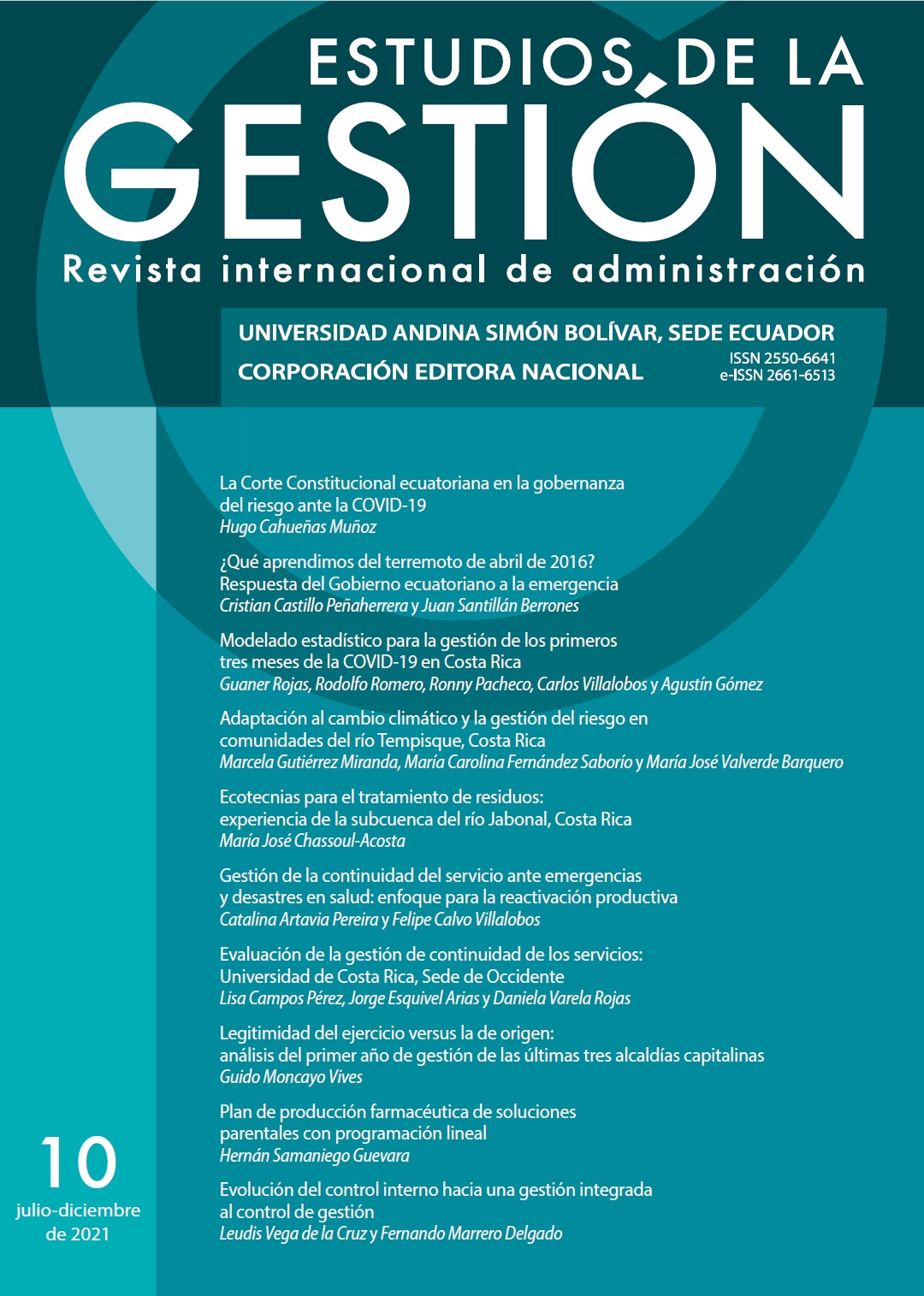Modelagem estatística para a gestão inicial de emergências: os primeiros três mesesde COVID-19 na Costa Rica
Conteúdo do artigo principal
Resumo
O papel da modelagem estatística na gestão de emergências é fundamental para delinear ou apoiar as decisões em torno da resposta aos eventos. Em 2020, com o surgimento da pandemia do coronavírus, os países rapidamente se prepararam para responder ao com-portamento de contágio e para o impacto que provocaria sobre a saúde pública. Na Costa Rica, uma equipe de especialistas preparou estudos sobre o comportamento da curva de contágio e seu efeito sobre a ocupação de leitos hospitalares durante os primeiros três meses da epidemia. Os estudos se basearam na estimativa de modelos estatísticos de crescimento exponencial e logístico, os quais proporcionaram prognósticos quanto ao número de casos diários e acumulados. A predição de casos permitiu alimentar um modelo de simulação para a projeção da demanda de leitos hospitalares por pacientes com COVID-19. As análises se basearam em dados fornecidos pelo Ministério de Saúde em relação aos casos confirmados de coronavírus a partir do aparecimento do primeiro caso na Costa Rica. Estimaram-se quatro modelos: logístico, Richards, Gompertz e exponencial, os quais geraram a estimativa de casos diários. Estimou-se também o número de reprodutibilidade por meio da estatística bayesiana de forma a quantificar a transmissibi-lidade do vírus. Os resultados permitiram antecipar o comportamento inicial do vírus na Costa Rica e o potencial efeito das medidas de contenção adotadas a partir da declaração de emergência nacional.
JEL: C15 Métodos de simulação estatística.
##plugins.themes.bootstrap3.displayStats.downloads##
Detalhes do artigo
Seção
Como Citar
Referências
Baty, Florent, Christian Ritz, Sandrine Charles, Martin Brutsche, Jean-Pierre Flandrois y Marie-Laure Delignette-Muller. 2015. “A Toolbox for Nonlinear Regression in R: The Package nlstools”. Journal of Statistical Software 66 (5): 1-21. http://www.jstatsoft.org/.
Chaves, Luis Fernando, Lisbeth Hurtado, Melissa Ramírez Rojas, Mariel Friberg, Rodrigo Marín Rodríguez y María Ávila-Agüero. 2020. “Covid-19 Basic Reproduction Number and Assessment of Initial Suppression Policies in Costa Rica”. MathematicalModelling of Natural Phenomena 15 (32): 1-13. https://doi.org/10.1051/mmnp/ 2020019.
Chowell, Gerardo, Lisa Sattienspiel, Sweta Bansai y Cécile Viboud. 2016. “Mathematical Models to Characterize Early Epidemic Growth. A Review”. Physics of Life Reviews 18 (1): 66-97. 10.1016/j.plrev.2016.07.005.
Cori, Anne, Simon Cauhemez, Neil Fergunson, Christophe Freiser, Elizabeth Dahlqwist, Alex Demarsh, Thibaut Jombart, Zhian Kamvar, Justin Lessler, Shikun Li, Jonathan Polonsky, Jake Stockwin, Robin Tompson y Robina van Galeen. 2020. Estimate Time Varying Reproduction Numbers from Epidemic Curves. R Project for Statistical Computing. R package version 2.2.4. PC y Mac OS.
Cori, Anne, Neil Ferguson, Christophe Fraser y Simon Cauchemez. 2013. “A New Fra-mework and Software to Estimate Time-Varying Reproduction Numbers During Epide-mics”. Practice of Epidemiology 178 (9): 1505-1512. 10.1093/aje/kwt133.
Grasselli, Giacomo, Antonio Pesenti y Maurizio Ceconi. 2020. “Critical Care Utilization for the COVID Outbreak in Lombardy, Italy”. American Medical Association 323 (16): 1545-1546. 10.1001/jama.2020.4031.
Livingston, Edward, y Karen Bucher. 2020. “Coronavirus Disease 2019 (COVID-19) in Italy”. American Medical Association 323 (14): 1335-1335. 10.1001/jama.2020. 4344.
Ministerio de Salud de Costa Rica. 2021. “Comunicados de prensa COVID-19”. Accedido enero. https://bit.ly/3rMKj13.
Nishiura, Hiroshi. 2010. “Correcting the Actual Reproduction Number: A Simple Method to Estimate R0 from Early Epidemic Growth Data”. International Journal of Environmental Research and Public Health 7: 291-302. 10.3390/ijerph7010291.
Oswald, Stephen, Ian Nisbet, Andre Chiaradia y Jennifer Arnold. 2012. “Flexparamcurve: R Package for Flexible Fitting of Nonlinear Parametric Curves”. Methods in Ecology and Evolution 3: 1073-1077. 10.1111/j.2041-210X.2012. 00231.x.
Paine, Timothy, Toby Marthews, Deborah Vogt, Drew Purves, Mark Rees, Andy Hector y Lindsay Turnbull. 2012. “How to Fit Nonlinear Plant Growth Models and Calculate Growth Rates: An Update for Ecologists”. Methods in Ecology and Evolution 3: 245-256.
Roosa, Kimberlyn, Yiseul Lee, Ruiyan Luo, Alexander Kirpich, Richard Rothenberg, James Hyman, Ping Yan y Gerardo Chowell. 2020. “Short-term Forecasts of the COVID-19 Epidemic in Guangdong and Zh ejiang, China: February 13-23, 2020”. Journal of Clinical Medicine 9 (596): 1-9. 0.3390/jcm9020596.
Spiess, Andrej-NiKolai. 2018. Propagation of Uncertainty Using Higher-Order Taylor Expansion and Monte Carlo Simulation. The R Project for Statistical Computing. R package version 1.0.6. PC y Mac. Montecarlo. Accedido enero de 2021. rdrr.io/cran/propagate/man/propagate.html.
Tjørve, Even, y Kathleen Tjørve. 2010. “A Unified Approach to the Richards-model Family for use in Growth Analyses: Why We Need Only Two Model Forms”. Journal of Theore-tical Biology 267: 417-425.
Torabipour, Amin, Hojjat Zeraati, Mohammad Arab, Arash Rashidian, Sari Akbari, Ali Sar-zaiem y Mahmuod Reza. 2016. “Bed Capacity Planning Using Stochastic Simulation Approach in Cardiac-surgery Department of Teaching Hospitals, Tehran, Iran”. Iranian Journal of Public Health 45 (9): 1208-1216. http://ijph.tums.ac.ir.


